In the wake of the George Floyd killing and the COVID-19- driven protests/riots that followed across the nation, Governor Kelly established the Governor’s Commission on Racial Equity and Justice last June. Not surprising was the Governor’s call for the commission to initially focus on law enforcement and criminal justice, following the nationwide outcry for reform from across the political and ideological spectrum. Specifically, Governor Kelly said, “By focusing this Commission initially on policing and law enforcement, we aim to make changes that will improve the safety of both citizens and police officers.”
The executive order that created the commission specifically identifies systemic racism as a Kansas problem. The order states the commission is to study “issues of racial equity and justice in Kansas, focusing first on policing and law enforcement then expanding the work to other systemic problems determined by members of the Commission.” (emphasis added) Furthermore, the executive order directs the commission to “(p)erform outreach…(to) people impacted by systemic racism.”
The commission released its initial report, which focused entirely on policing/criminal justice issues, in December. But the commission’s effort is far from finished. Included in the report is the statement that the “Commission is tasked with studying issues of racial equity and justice across systems in Kansas including, criminal justice, health and mental health, education, housing, and economic opportunity.”
Beyond a doubt, racism continues to be an issue in need of addressing beyond that of just the policing and justice systems. I certainly hope that education is the next issue the commission tackles. Because, as the data supports, there is unquestionably systemic racism in public education in Kansas.
Historically, there has been a substantial achievement gap between white and black students in K-12 public education across the state, and the country.
As the graphs below so brazenly illustrate there are indeed wide achievement gaps between white and black students. And these gaps are not shrinking. The National Assessment of Educational Progress (NAEP) is given to a representative sample of 4th and 8th graders across the nation every two years in the subjects of math and reading. The results form the Nation’s Report Card which has been called the “gold standard” of assessments by KSDE. The two NAEP graphs show the disparity between black and white students, both in terms of proficiency and performing below grade level.
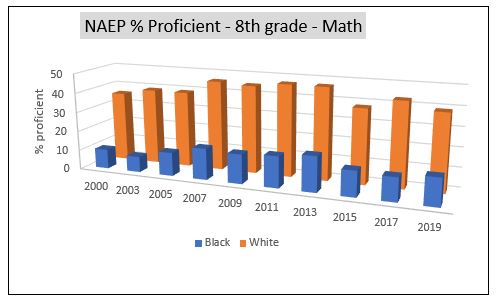
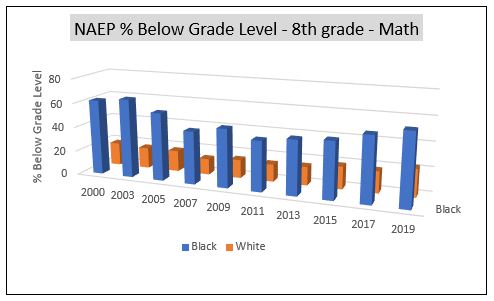 These achievement gaps have been consistent since Kansas started participating in NAEP. Here are the average percentage point gaps between black and white eighth-grade students over time:
These achievement gaps have been consistent since Kansas started participating in NAEP. Here are the average percentage point gaps between black and white eighth-grade students over time:
- Reading – % proficient – 26.2
- Reading – % below grade level – 27.8
- Math – % proficient – 28.5
- Math – % below grade level – 35.0
These gap numbers are similar for fourth-grade students in both subjects.
For the Kansas state assessments, given annually to 3rd through 8th grades and 10th grade, the results are just as eye-opening.
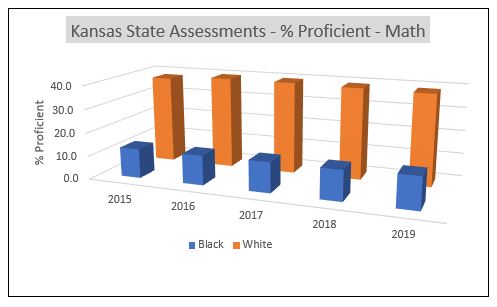
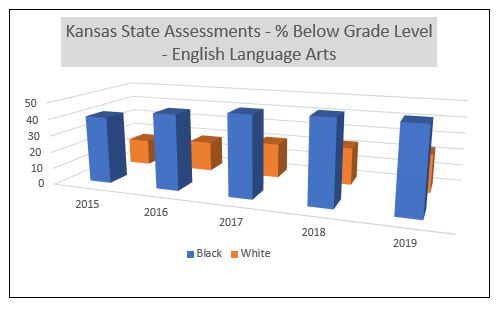 These performance differences persist for those who aspire to attend college. There has been a consistent substantial achievement gap for those who take the ACT. White students have historically had a composite average of about 22.5 compared to black students at about 17.5. This gap is exacerbated when looking at what ACT calls college-readiness (English, reading, math and science) where, in 2020, 28.3% of white students were considered college-ready and only 6% black students were.
These performance differences persist for those who aspire to attend college. There has been a consistent substantial achievement gap for those who take the ACT. White students have historically had a composite average of about 22.5 compared to black students at about 17.5. This gap is exacerbated when looking at what ACT calls college-readiness (English, reading, math and science) where, in 2020, 28.3% of white students were considered college-ready and only 6% black students were.
Urban high schools with large concentrations of black students perform far lower than state averages.
According to KSDE statistics, black students comprised 6.9% of students statewide during the 2018-19 school year. Most urban high schools had a much larger concentration of black students than the statewide numbers. Unfortunately, in those schools, overall performance (all students) was lower than state averages as was the achievement of black students relative to all black students statewide. The table below shows the performances in five selected urban high schools and how they compared with state totals.
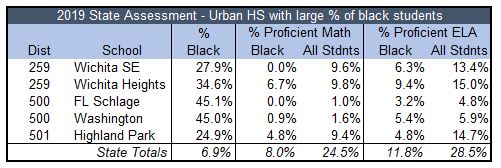 The data speaks for itself. Higher concentrations of black students are stuck in extremely low performing schools, which impact not only the black students but all the students. There is no question that this is a systemic problem that needs immediate attention.
The data speaks for itself. Higher concentrations of black students are stuck in extremely low performing schools, which impact not only the black students but all the students. There is no question that this is a systemic problem that needs immediate attention.
There is a huge gap between graduation rates and achievement among black students.
For the class of 2019, the graduation rate for black students, as calculated by KSDE was 81.1%. That doesn’t reconcile with other achievement indicators. The table below illustrates a timeline of performance for black students in the graduating class of 2019. Although this isn’t by any means a pure cohort analysis, it certainly provides an overview of the disconnect between achievement and graduation.
 Recommendations
Recommendations
More money is not the answer.
It’s standard procedure whenever government, at whatever level, identifies a problem the solution is always the same: more money. That’s been tried in education and it hasn’t worked. The vast increase in K-12 spending in Kansas certainly hasn’t helped the achievement of black students. The accompanying graph is Exhibit A.
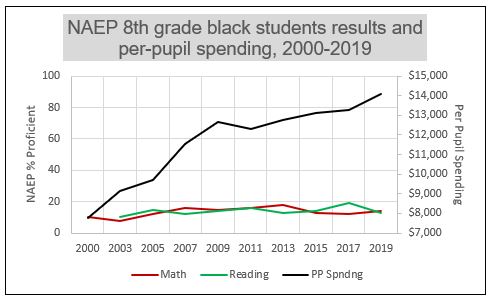 Since Kansas started participating in NAEP in 2000 (2003 for reading), the percentage of 8th graders proficient in both math and reading has been essentially flat, while per-pupil spending has increased over 83% to $14,085 in 2019.
Since Kansas started participating in NAEP in 2000 (2003 for reading), the percentage of 8th graders proficient in both math and reading has been essentially flat, while per-pupil spending has increased over 83% to $14,085 in 2019.
An even greater increase in targeted money through the at-risk program – in which black students are over-represented – has failed to impact the achievement of low performing black students. The following graphic is a visual presentation that while at-risk spending increased over 10-fold between 2000 and 2019 to $413 million, the percentage of black 8th graders who are performing below grade level has changed little. In reading, the percentage between 2003 and 2019 is unchanged, while in math the percentage of those scoring below grade level has dropped only from 62% to 58%.
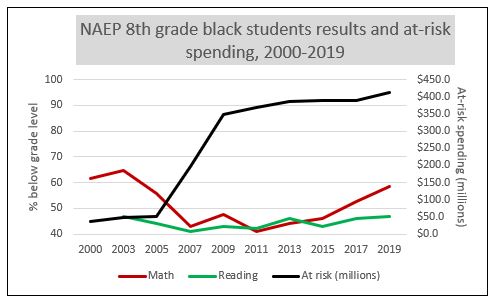 Systemic problems require systemic change. Throwing more money at the already bloated coffers of school districts across the state – the latest unencumbered cash balances of all the districts combined total nearly $1 billion – will do nothing to initiate or facilitate systemic change. In fact, a “more money” approach incentivizes the K-12 establishment to continue a “business as usual” approach.
Systemic problems require systemic change. Throwing more money at the already bloated coffers of school districts across the state – the latest unencumbered cash balances of all the districts combined total nearly $1 billion – will do nothing to initiate or facilitate systemic change. In fact, a “more money” approach incentivizes the K-12 establishment to continue a “business as usual” approach.
Provide mechanisms for black students – and all students – to escape failing schools.
There are a variety of systemic changes that can be made to improve the educational opportunities, not only for black students but all students across Kansas.
- Expand the current tax credit scholarship program. Currently, participation in the tax credit scholarship program, which allows eligible students scholarships to private schools, is limited to those coming from the 100 lowest performing elementary schools in Kansas. That cap should be lifted so that, at a minimum, students attending any Title I school can participate.
- Change the Kansas charter school law. Studies have shown that students in public charter schools outperform their traditional public-school counterparts. Black students, in particular, benefit from attending a charter school. Kansas has charter schools in name only because the current law only allows school districts to authorize the formation of charter schools. That is why there are currently only ten charter schools in the state. The Kansas charter school law is consistently ranked at or near the bottom of all states that have charter school laws. In order to expand charter school opportunities, the law needs to be changed to increase the number of authorizers in the state.
- Provide funding for students to attend private schools. Now that the U.S. Supreme Court has ruled (in Espinoza v. Montana) that public money can be used for private schools including religious schools, it is time the Kansas Legislature provides such funding to Kansas students. In particular, studies have shown that minority students perform better in Catholic schools.
Improve the use of at-risk funding.
What started as a modest program in 1992 – the at-risk funding level was $13 million the first year – has now become a major source of revenue for school districts. As one would expect, the purpose of an at-risk program is to address the needs of students who are considered at risk of failing academically. Clearly, the program has not worked. It was documented by KPI research and more recently by the Kansas Legislative Post Audit. LPA concluded
most at-risk spending was used for teachers and programs for all students and did not appear to specifically address at-risk students as required by state law.
The failure of the public school system to use at-risk funds as prescribed is another systemic failure. Since a disproportionate share of black students is performing below grade level, as evidenced by NAEP and Kansas state assessment results, this failure falls particularly hard on that student population.
Clearly, a new at-risk model is necessary, one that replaces the existing approach with one that focuses on improving the student achievement of those who struggle academically.
Conclusion
Commission co-chair, Dr. Shannon Portillo said of their mission, “We are seeing a call for systemic change across the country, and I am thrilled that Governor Kelly has been clear in her response…I look forward to…making policy and practice recommendations that address inequities in Kansas.” The commission acknowledges the need to move on from the singular focus of policing/ law enforcement justice. To wit, “This report does not mark the end of our job, and we know there is still much work to be done to address other areas of racial inequity and injustice in Kansas.” What more appropriate issue to address next than education, where the outcomes between black students and white students are clearly inequitable.




